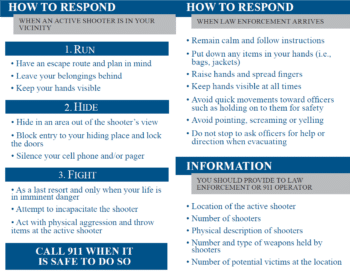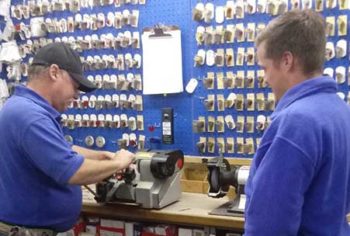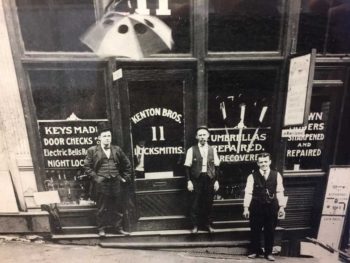Update: How to increase your survival chances in an active shooter scenario
By David Strickland, Vice President of Kenton Brothers
On October 1st, 2017, a gunman opened fire on a country music festival in Las Vegas from an elevated position. Eleven minutes later, a staggering 58 people are dead and an additional 851 are injured. This opened a larger debate about the why and how of active shootings in the USA. For this blog, we will be concentrating on the “how to increase your chances of survival” aspect of this conversation.
As we discussed in our “5 Critical things you must do in an active shooter situation“, preparing for this type of event is important and critical to your survival if you ever face this situation. Kenton Brothers has an array of solutions to help your business, schools place of worship or public building prevent an active shooter scenario however you may find yourself as a part of one while in a public area or venue. (Download our PDF here.)
RUN HIDE FIGHT, is the common active shooter plan that’s recommended by the Department of Homeland Security (DHS), The FBI and FEMA. After Las Vegas and the lessons learned from that incident, a few additional clarifications to this policy have been made.

FIRST: PREPARE
1. Prepare yourself through training by taking an online or live active shooter preparation course
- Active Shooter: What You Can Do
- Read the active shooter preparedness guide from DHS
 2. Actively seek out response plans at work and in community gathering places.
2. Actively seek out response plans at work and in community gathering places.
If you are spending the day at a major league baseball game don’t be afraid to call ahead and ask security for evacuation routes and what their response will be to an active shooter scenario. If your workplace does not have an active shooter response plan then please have them call Kenton Brothers Systems for Security to help them create a comprehensive security plan. FEMA offers this simple one page active shooter planning sheet to hand out to employees.
3. Practice situational awareness – always
a. “Keep your head on a swivel” or “watch your six” are two common slang terms for actively being aware of your surroundings and the people in them at all times. This is a practices skill and over time you will be able to detect things that are out of place or tip off aggression. In public places being actively aware of noises, aggressive behavior, shouting, the speed at people are moving are indicators of situations around you. Tuning yourself with these indicators can give you precious seconds to react and seek safety.
b. Trust your gut! Intuition plays a big role on situational awareness. If something doesn’t feel right, it usually isn’t.
c. Make yourself aware of all exits, cover and concealment in your current location. Take a few moments to absorb the area around you and log them into your memory of where you will need to go if you find yourself in an active shooter situation.
My family and I recently attended a large Christmas lighting ceremony and I positioned our group in an area directly below the police watch tower. There were three different areas of escape next to a large building that offered cover in case there was any trouble. We also spoke of what to do if there’s trouble, and prepared the family mentally for what to do if something went wrong. In this case, we had an emergency word that meant we all hold hands, dad in front, mom in back, and move together as quickly as possible ,staying low to cover.
DHS and the FBI stress that after Las Vegas, it is important for everyone to adapt tactics to survive and outdoor scenarios.
Run – if you properly identified he exits and evacuation routes –use them now! If you have a responsibility of care – usher your group to one of these points (away from the shooter) as quickly as possible.
Hide – Find Concealment or Find Cover. And yes, there’s a difference between concealment and cover! The people that survived Las Vegas were able to conceal themselves from the shooter or find cover that protected them from the 1,100 bullets that were fired at them.
Concealment: Protection from observation
This can be any barrier to the line of sight between you and an armed assailant. Examples include Bushes, Trees, Doors, Curtains, Smoke, darkness, Anything that keeps you from being seen or heard – so silence your cell phone!
Good Cover: Protection from hostile weapons, bullets or shrapnel
 Steel – such as a large gun safe, Concrete, Brick, Water, Large Trees, Thick wood furniture, Packed down earth or sandbags, Fire hydrants, Large boulders, Car engine, Refrigerators, Water heaters, US Post office
Steel – such as a large gun safe, Concrete, Brick, Water, Large Trees, Thick wood furniture, Packed down earth or sandbags, Fire hydrants, Large boulders, Car engine, Refrigerators, Water heaters, US Post office
Bad Cover:
Bushes, Wood fencing, Glass, Normal residential walls, Car doors
The last update recommendation from DHS was to add the following recommendations for after the scenario. Give or seek out medical attention and help others survive. Then seek out psychological help with coping with the trauma you have experienced.
In summary, it’s important to prepare for these types of situations by utilizing the resources available to you and using active situational awareness when attending public events. Please feel free to reach out to us at KentonBrothers.com if you would like to discuss formulating a security plan for your business, church or public venue.
Additional resource:
http://alerts.si.edu/docs/DHS_ActiveShooterBook.pdf

 By
By  Each apprentice will start at our
Each apprentice will start at our 





